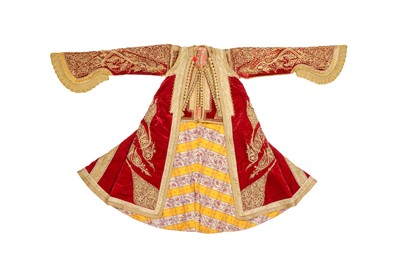28th Apr, 2023 14:00
Islamic & Indian Art
A RARE WOMAN’S PIRIPIRI GOLD AND SILVER-THREAD EMBROIDERED RED VELVET WEDDING ENSEMBLE
Ottoman Greece or Albania, 19th century
A RARE WOMAN’S PIRIPIRI GOLD AND SILVER-THREAD EMBROIDERED RED VELVET WEDDING ENSEMBLE
Ottoman Greece or Albania, 19th century
Comprising a long tunic of fine royal crimson red velvet, the tight bodice and swing A-line drop elegantly worked in metallic filigree, bands and twisted rope thread with sweeping and scrolling designs, the front edge with double-conical shaped buttons surmounted by coral beads, lined in roller-printed floral cotton in purple and yellow, 110cm from the nape; a matching bolero with dramatic fan-shaped cuffs, lined in Russian roller-printed cotton, 36cm from the nape, sleeve length 72cm; and a matching light gilet, lined in roller-printed cotton of floral design within repeating geometric grid, 40cm from the nape.
Fashion and clothing have the ability to transport us back in time in a way that few other objects or textiles can. These garments were worn, used, mended, stitched, tailored, cleaned, treasured and handed over to the next generation of the families to whom they belonged. This impressive female piripiri set is not an exception. The lavish use of materials and embellishment on this ensemble is both masterful and informative. The skillful embroidery depicts motifs and patterning that illustrate the cross-cultural influences in the Western Ottoman Christian provinces. A ‘couture’ creation, this set, most likely to be associated with nobility, outshines most contemporary examples of its type. The care and precision of execution (though not the exact design) and the superior quality of materials may be compared to the Albanian woman’s wedding coat at the Costume Institute of the Metropolitan Museum of Art (Accession Number 2009.300.964).
To quote Angeliki Hatzimichali: ‘this [type of] costume, ornamented with valuable jewellery, must have been one of the costliest costumes of Greece; only the wealthiest merchants in Yannina could have afforded such expenditures. (Hatzimichali, A., (1984) Vol II, The Greek Folk Costume, P.171, The Older Costume of Yannina). The survival of so many items in the ensemble, in such dazzling conditions, is exceptionally rare.
Sold for £4,000
Includes Buyer's Premium
Do you have an item similar to the item above? If so please click the link below to submit a free online valuation request through our website.












